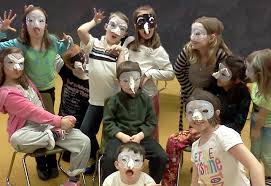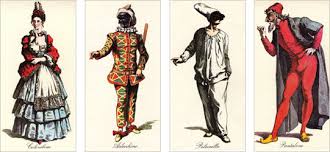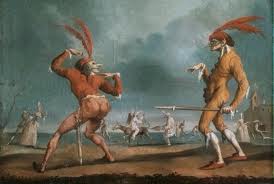

Character Walks
Since Commedia Dell’ Arte is a physical theatrical art form, it is essential and fun to have students experiment with various ways of moving their bodies. Have the students walk around the classroom as a character of their choice. After a couple of minutes, ask them to pretend that an invisible string is attached to the top of their head. This string is pulling them through the space around them, causing them to lead with their head. Ask the students to analyze what the rest of their body is doing. How does leading with the head change the way they walk? Do they walk faster or slower? Have the students explore who their characters might be: what is their character’s name and occupation? Have them create a voice for their character. Experiment with attaching the string to different body parts, such as the nose, knees, hip, elbow, etc. It is beneficial and fun to take time and allow the students to discuss what characters they invented.
The Stock Characters

Now that the students are warmed up and comfortable moving their bodies in a variety of ways, discuss and explore all of the main stock characters in Commedia dell’ Arte:
Commedia dell’ Arte characters symbolized fixed social types. Characters such as Arlecchino, Pantalone, and Il Dotore started off as caricatures of Italian “types,” and they became the inspiration for many of the popular characters of 17th and 18th century European theatre.
- Arlecchino, wearing a cat-like mask and a colorful patched costume, was known for being humorous. He was a poor and rebellious character, always hungry and not having any money. Despite his struggles, he was comedic and creative enough to persevere.
- Brighella was Arlecchino’s sidekick. He was a violent, over-the-top womanizer and his mask portrayed this. He was a catlike villain who was sleazy in his search for food, a convincing liar in his pursuit of women, and he was always scheming.
- Il Capitano was the Captain and a satire of the professional soldier. He typically wore a long pointy moustache, carried a huge sword (that he never used), and had a few daggers in his belt. He was courageous with his words, but cowardly in his actions.
- Il Dotore (the doctor) wore a mask that feigned having abundant knowledge, but he actually pompous and all talk. He was rather fat, which back then meant one was wealthier, and he was always well-groomed.
- Pantalone was the wealthy, greedy, and unwise Venetian merchant. He constantly always had people attempting to steal his gold from him, and he would lose to their humor and improvisation. He was old and retired, but still physical.
- Pedrolino was a white-faced dreamer and the forefather of today’s clown.
- Pulcinella was a philosophical dreamer and had a unique soul with a positive approach to life. He was a dwarfish hunchback with a crooked nose who chased girls.
- Scarramucia was the hero, dressed in black and carrying a pointed sword.
- The Inamorato (lover) went by many names. He did not wear a mask and was the male ingénue.
- The Inamorata was his female lover.
- La Ruffiana was an elderly woman who disenchanted the young lovers.
- Cantarina and Ballerina primarily sang, danced, or played music, although sometimes they were involved in the comedy.
Just as the students did in the previous activity, have them analyze how these characters may walk, talk, dress, stand, etc. What body parts would they choose to lead with? Experiment by having the class walk around the classroom. Have the students take turns presenting their stock character of choice to the class and have everyone guess each other’s character. Remember to encourage constructive criticism.
Classroom Comedy

Lazzi are the comedy routines of Commedia dell’ Arte. These routines are disconnected from the complex storylines and arise spontaneously. Specialized lazzi can be planned or unplanned, and can be acrobatic or absolutely obscene. These scenes do not typically contribute to the plot, and are solely meant to satisfy the audience’s hunger for humor.
The objective of this activity is to have the class take part in creative writing, using their imaginations to create their very own lazzi scenes that can be performed in class. First, have a class discussion about comedy. Explain the definition of slapstick. “A slapstick is a theatrical prop made out of two thin strips of wood separated at the handle. When the slapstick hits an object, the two pieces of wood slap against each other and create a loud sound without hurting the other person. This prop inspired the name for ‘slapstick comedy’”. Show clips of any slapstick comedy performances you can find (such as The Three Stooges or Charlie Chaplin).
As a class, explore different classroom scenarios that could be deemed lazzi. For example, “Students are on their way to school,” “A group of friends are playing at the beach,” or “A student is late to class.” Afterwards, split them up into small groups of three or four to write their own scenes. When they are finished, have the groups share their scenarios. Then put them all in a hat and have each group pick one scene at random that they will work on to present to the entire class. Teachers should remind the students (especially younger kids) that violence and obscenity are essential parts of Commedia dell’ Arte. It is beneficial to discuss as a class the difference between staged action and using slapstick as an alternate means of slapping someone.
Exploring Theatrically
Having students stretch themselves as performers can be enlightening. Commedia dell’ Arte is a great way to experiment, explore, and take some risks while having fun. Enjoy the process of learning. To read Part I of this two-part series, please follow this link.

 Random Item
Random Item